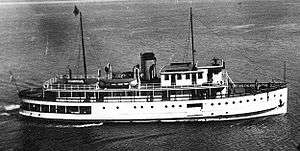USAT General John McE. Hyde
 Sister-ship General Frank M. Coxe calls at Alcatraz, c. 1935 | |
| History | |
|---|---|
| Builder: | Charles Ward Engineering Works, Charleston, West Virginia[1] |
| Laid down: | 18 July 1921[1] |
| Launched: | 11 March 1922[1] |
| Acquired: | delivered 5 December 1922[2] |
| Decommissioned: | 1942 |
| Fate: | Sunk by Japanese artillery, Corregidor, Philippines 1942 |
| General characteristics | |
| Class and type: | Troop ferry |
| Tonnage: | 900 GT[3] (539 - unspecified)[4] |
| Length: | 144 ft (44 m) (LBP)[1] |
| Beam: | 28 ft (8.5 m)[1] |
| Depth: | 9 ft (2.7 m)[1] |
| Propulsion: | 2 Ward water tube boilers[1] |
General John McE. Hyde was a ferry boat built for the War Department by Charles Ward Engineering Works. The ferry was assigned to provide transportation services among the military facilities in Manila Bay, Philippines under administrative command of the Coast Artillery Corps.[5]
General John McE. Hyde was sunk during World War II during the Battle of Corregidor,[3] by Japanese aircraft on 26 December 1941 after safely delivering nurses from Manila to establish Hospital #2 at Coclaban.[6][7][Note 1]
Design and construction
General John McE. Hyde was among the hundreds of small vessels acquired after the Spanish American War and during the early part of the Twentieth Century to support overseas outposts that were owned and operated by the US Army for specific logistical purposes.[3]
This vessel along with a sister-ship, General Frank M. Coxe, was designed and built shortly after World War I, to ferry army personnel within strategic harbors. It was designed by the New York firm of Cox & Stevens,[8] who were renowned Naval Architects specializing in yachts and small commercial and military craft. The Hyde was built in 1921, followed in 1922 by General Frank M. Coxe, to Cox & Stevens design #244.[8] The ships were built on the Kanawha River, by Charles Ward Engineering Works of Charleston, West Virginia, a firm which specialized in shallow draft vessels such as ferries, riverboats, and tugs.[4][9]
Hyde's keel was laid 18 July 1921 with launch on 11 March 1922.[1] The ship was delivered to the War Department on 5 December 1922.[2] The vessel was 900 gross tons,[3] 539 tons unspecified measurement in some references,[4] 144 ft (44 m) in length between perpendiculars with a beam of 28 ft (8.5 m) and draft of 9 ft (2.7 m).[1]
Operations
Hyde provided general logistical and passenger service to the island forts and other installations in Manila Bay, including transportation of dependents.[10] In 1932 General John McE. Hyde and Miley, a local vessel, ran daily shuttle schedules on the Corregidor-Manila service with General John McE. Hyde leaving Corregidor on the two and a half hour run at 8:00 a.m., returning from Manila at 4:00 p.m. and Miley leaving Manila at 10:00 a.m. and returning from Corregidor at 4:00 p.m.[11] The vessel played an important role in garrison life, including social events, as noted in a story from 1939:
- The social highlight of the month of March was the reception for the Army and Navy given at Malacanan by President and Mrs. Quezon. Encouraged by an appropriate harbor boat sailing to and from Manila, the captains and field officers donned their shiniest buttons and responded to the invitation in such numbers that the skipper of the Hyde hung out the SRO sign on the trip home.[12]
On 25 December 1941 twenty nurses were evacuated from Manila aboard Hyde destined for Hospital #2 at Coclaban with vessel lost to air attack with medical supplies for the hospital shortly after.[6][13]
Notes
- ↑ Barr has a much later date that is contradicted by other sources.
References
- 1 2 3 4 5 6 7 8 9 Pacific Marine Review (1922). "The Charles Ward Engineering Works, Charleston, West Virginia". Consolidated 1922 issues (November 1922). 'Official Organ: Pacific American Steamship Association/Shipowners' Association of the Pacific Coast: 651. Retrieved 27 August 2014.
- 1 2 Pacific Marine Review (1923). "American Shipbuilding—Deliveries". Consolidated 1923 issues (January 1923). 'Official Organ: Pacific American Steamship Association/Shipowners' Association of the Pacific Coast: 61. Retrieved 27 August 2014.
- 1 2 3 4 Grover, David H. (1987). U.S. Army Ships and Watercraft of World War II. Annapolis, Md.: Naval Institute Press. pp. 74–75, 84 & 86. ISBN 0-87021-766-6.
- 1 2 3 T. Colton (22 September 2010). "Ward Engineering, Charleston WV". Shipbuilding History. Retrieved 12 March 2012.
- ↑ Moore, George F., Major General. "Organization of the Coast Artillery in the Philippines". United States Coast Artillery of Manila and Subic Bays, 1941. Retrieved 12 March 2012.
- 1 2 Wise, James E., Jr.; Baron, Scott (2006). Women at War. Annapolis, Maryland: Naval Institute Press. p. 166.
- ↑ Barr, Lt. Col. E. L. ""MOBILE" Battery "M" 60th coast artillery (a.a.)"., describes the sinking of General John McE. Hyde
- 1 2 "General Frank M. Coxe: River steamer, Design #244". Mystic Seaport Museum, Inc. Retrieved 9 March 2012.
- ↑ "Manuscript Collections". West Virginia State Archives. Retrieved 2013-06-06. Description of Charles Ward Engineering.
- ↑ Calmes, Selma Harrison, MD. "Lost Corregidor: The Home Front Life Before WW II, Part 2". Historic Corregidor. Corregidor.org. Retrieved 12 March 2012.
- ↑ Heaney, Lieut. G. F., Jr., C. A. C. (July–August 1932). "Corregidor: An Estimate of the Situation". The Coast Artillery Journal. United States Coast Artillery Association. 75 (4): 285.
- ↑ Phillips, Lieutenant Colonel R. E. (May–June 1939). "Corregidor". The Coast Artillery Journal. United States Coast Artillery Association. 82 (3): 272.
- ↑ Norman, Elizabeth M. (1999). We Band of Angels: The Untold Story of American Nurses Trapped on Bataan. Random House. ISBN 9780307799579.
Bibliography
- National Park Service – Maritime Heritage Program Historic Ships to Visit – Listed by Name, specifications of the Coxe
- Mystic Seaport Museum, Inc. Coll. 34, Daniel S. Gregory Ships Plans Library